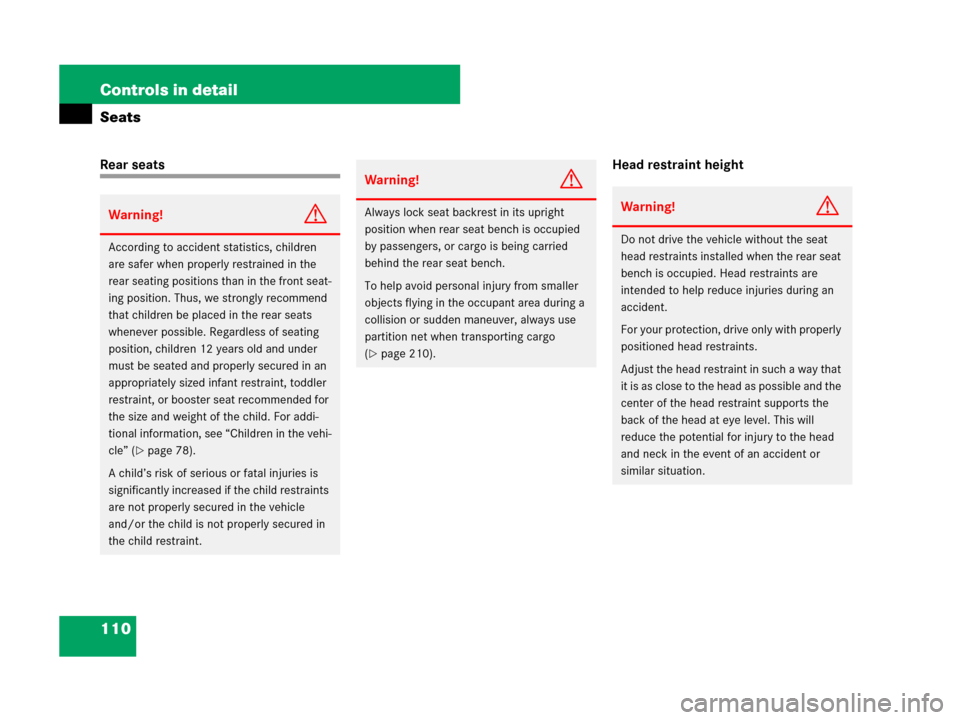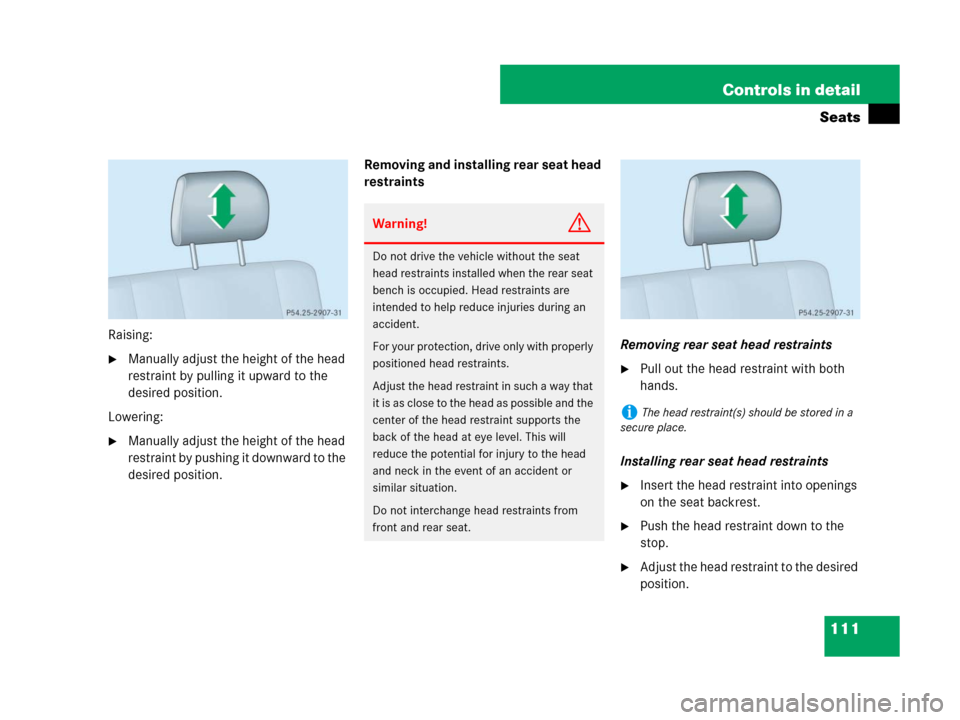Page 95 of 457

94 Safety and Security
Driving safety systems
Switching off the ESP®
To improve the vehicle’s traction, switch
off the ESP® in driving situations where it
would be advantageous to have the drive
wheels spin and thus cut into surfaces for
better grip such as:
�when driving with snow chains
�in deep snow
�sand or gravel
�when driving off-roadWhen you switch off the ESP
®
�the ESP® does not stabilize the vehicle
�the engine output is not limited, which
allows the drive wheels to spin and
thus cut into surfaces for better grip
�the 4-ETS will still apply the brake to a
spinning wheel
�the ESP® continues to operate when
you are braking
�you cannot activate the cruise control
system
�the cruise control system switches off
if currently activatedThe ESP
® switch is located on the upper
part of the center console.
1ESP
® switch
�With the engine running, press
switch1.
The ESP
® warning lampv in the
instrument cluster comes on.
The ESP
® is deactivated.
Warning!G
The ESP® should not be switched off during
normal driving other than in the circum-
stances described below. Disabling of the
system will reduce vehicle stability in stan-
dard driving maneuvers.
Warning!G
Switch on the ESP® immediately if the afore-
mentioned circumstances do not apply any-
more. Otherwise the ESP
® will not stabilize
the vehicle when it is starting to skid or a
wheel is spinning.
iWhen the ESP® is switched off and one or
more drive wheels are spinning, the ESP® warn-
ing lampv in the instrument cluster flashes.
However, the ESP
® will then not stabilize the
vehicle.
Page 96 of 457

95 Safety and Security
Driving safety systems
Even if the ESP® has been switched off, it
is still active in the following situations:
�when braking
�at vehicle speeds up to approximately
37 mph (60 km/h), if one wheel
reaches the grip limit, e.g. when the
street is icy on one side
The brake is applied until the wheel
regains sufficient traction.
If one or more drive wheels are spinning,
the ESP
® warning lampv in the instru-
ment cluster flashes, regardless of the
speed.Switching on the ESP
®
�Press switch1 once more.
The ESP
® warning lampv in the
instrument cluster goes out.
You are now again in normal driving
mode with the ESP
® switched on.
For more information, see “Practical hints”
(
�page 330).
Warning!G
When the ESP® warning lampv is
illuminated continuously, the ESP® is
switched off or it is not operational due to a
malfunction.
Adapt your speed and driving to the prevail-
ing road conditions and to the non-operating
status of the ESP
®.
!Avoid spinning of a drive wheel for an
extended period of time with the ESP® switched
off. This may cause serious damage to the
drivetrain which is not covered by the
Mercedes-Benz Limited Warranty.
iIf the ESP® is switched off, it will be auto-
matically activated when exceeding a vehicle
speed of 37 mph (60 km/h) or exceeding a
severity threshold of side acceleration.
Page 97 of 457

96 Safety and Security
Anti-theft systems
Immobilizer
The immobilizer prevents unauthorized
persons from starting your vehicle.
Activating
�Remove the SmartKey from the starter
switch.
Deactivating
�Turn the SmartKey in the starter switch
to position2 (
�page 39).
Anti-theft alarm
Once the alarm system has been armed, a
visual and audible alarm is triggered when
someone opens
�a door
�the tailgate
�the hood
The alarm will stay on, even if the activat-
ing element (a door, for example) is imme-
diately closed.The alarm system will also be triggered
when
�someone attempts to raise the vehicle
�the vehicle is opened with the
mechanical key
�someone opens a door from the inside
�someone opens the tailgate from the
inside
iStarting the engine will also deactivate the
immobilizer.
In case the engine cannot be started (yet the
vehicle’s battery is charged), the system is not
operational. Contact an authorized
Mercedes-Benz Light Truck Center or call
1-800-FOR-MERCedes (in the USA), or
1-800-387-0100 (in Canada).
Page 98 of 457

97 Safety and Security
Anti-theft systems
Arming the alarm system
The alarm system is armed after you have
locked the vehicle with the SmartKey.
The alarm system indicator lamp is located
in the tow-away alarm switch on the upper
part of the center console.
1Alarm system indicator lamp�Make sure all doors and the tailgate are
closed.
�Lock the vehicle with the SmartKey
(
�page 65).
The turn signal lamps flash three times
to indicate that the vehicle is locked.
The alarm system is armed within
approximately 15 seconds. Alarm
system indicator lamp1 flashes.Disarming the alarm system
�Unlock the vehicle with the SmartKey
(
�page 38).
The turn signal lamps flash once to
indicate that the alarm system is
disarmed. Alarm system indicator
lamp1 goes out.
Canceling the alarm
�Insert the SmartKey in the starter
switch.
or
�Press buttonŒ or‹ on the
SmartKey.
iIf the turn signal lamps do not blink three
times, one of the following elements may not be
properly closed:
�a door
�the tailgate
Close the respective element and lock the
vehicle again.
iThe alarm system will rearm automatically
after approximately 40 seconds if neither a door
nor the tailgate is opened.
Page 99 of 457

98 Safety and Security
Anti-theft systems
Tow-away alarm
Once the tow-away alarm is armed, a visual
and audible alarm will be triggered when
someone attempts to raise the vehicle.
Arming tow-away alarm
�Lock the vehicle with the SmartKey
(
�page 65).
The tow-away alarm is automatically
armed after approximately
30 seconds.Disarming tow-away alarm
To prevent triggering the tow-away alarm
feature, switch off the tow-away alarm
before towing the vehicle, or when parking
on a surface subject to movement, such as
a ferry or auto train.
The tow-away alarm off switch is located
on the upper part of the center console.
1Tow-away alarm off switch
2Indicator lamp
�Switch off the ignition and remove the
SmartKey from the starter switch.
�Press switch1.
Indicator lamp2 comes on briefly.
�Exit and lock the vehicle with the
SmartKey (
�page 65).
Canceling the tow-away alarm
�Press theŒ or‹ button on the
SmartKey.
or
�Insert the SmartKey in the starter
switch.
iYou cannot disarm the tow-away alarm
when the ignition is switched on.
iWhen you unlock the vehicle, the tow-away
protection disarms automatically.
The tow-away alarm remains disarmed until you
lock your vehicle again.
Page 111 of 457

110 Controls in detail
Seats
Rear seats Head restraint height
Warning!G
According to accident statistics, children
are safer when properly restrained in the
rear seating positions than in the front seat-
ing position. Thus, we strongly recommend
that children be placed in the rear seats
whenever possible. Regardless of seating
position, children 12 years old and under
must be seated and properly secured in an
appropriately sized infant restraint, toddler
restraint, or booster seat recommended for
the size and weight of the child. For addi-
tional information, see “Children in the vehi-
cle” (
�page 78).
A child’s risk of serious or fatal injuries is
significantly increased if the child restraints
are not properly secured in the vehicle
and/or the child is not properly secured in
the child restraint.
Warning!G
Always lock seat backrest in its upright
position when rear seat bench is occupied
by passengers, or cargo is being carried
behind the rear seat bench.
To help avoid personal injury from smaller
objects flying in the occupant area during a
collision or sudden maneuver, always use
partition net when transporting cargo
(
�page 210).
Warning!G
Do not drive the vehicle without the seat
head restraints installed when the rear seat
bench is occupied. Head restraints are
intended to help reduce injuries during an
accident.
For your protection, drive only with properly
positioned head restraints.
Adjust the head restraint in such a way that
it is as close to the head as possible and the
center of the head restraint supports the
back of the head at eye level. This will
reduce the potential for injury to the head
and neck in the event of an accident or
similar situation.
Page 112 of 457

111 Controls in detail
Seats
Raising:
�Manually adjust the height of the head
restraint by pulling it upward to the
desired position.
Lowering:
�Manually adjust the height of the head
restraint by pushing it downward to the
desired position.Removing and installing rear seat head
restraints
Removing rear seat head restraints
�Pull out the head restraint with both
hands.
Installing rear seat head restraints
�Insert the head restraint into openings
on the seat backrest.
�Push the head restraint down to the
stop.
�Adjust the head restraint to the desired
position.
Warning!G
Do not drive the vehicle without the seat
head restraints installed when the rear seat
bench is occupied. Head restraints are
intended to help reduce injuries during an
accident.
For your protection, drive only with properly
positioned head restraints.
Adjust the head restraint in such a way that
it is as close to the head as possible and the
center of the head restraint supports the
back of the head at eye level. This will
reduce the potential for injury to the head
and neck in the event of an accident or
similar situation.
Do not interchange head restraints from
front and rear seat.
iThe head restraint(s) should be stored in a
secure place.
Page 115 of 457

114 Controls in detail
Memory function
Prior to operating the vehicle, the driver
should check and adjust the seat height,
seat position fore and aft, and seat back-
rest angle if necessary, to ensure adequate
control, reach and comfort. The head
restraint should also be adjusted for
proper height. See also the section on
air bags (
�page 70) for proper seat
positioning.
In addition, adjust the steering wheel to
ensure adequate control, reach, operation
and comfort. Both the interior and exterior
rear view mirrors should be adjusted for
adequate rear vision.
Fasten seat belts. Infants and small
children should be seated in a properly
secured restraint system that complies
with U.S. Federal Motor Vehicle Safety
Standards 213 and 225 and Canadian
Motor Vehicle Safety Standards 213 and
210.2.With the memory function you can store up
to three different configurations.
Each stored position on the driver’s side
includes the following settings:
�Seat position
�Multicontour seat*: previously saved
setting
�Steering wheel position
�Exterior rear view mirrors’ positionEach stored position on the passenger side
includes the following settings:
�Seat position
�Multicontour seat*: previously saved
setting
Warning!G
Do not activate the memory function while
driving. Activating the memory function
while driving could cause the driver to lose
control of the vehicle.